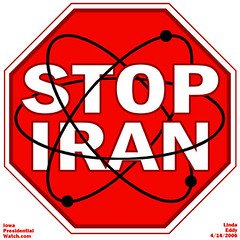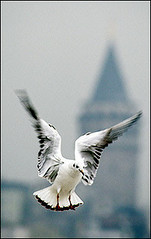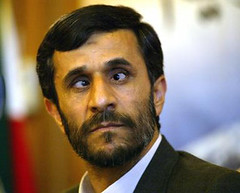Tuesday, April 10, 2007
SABRE RATTLING OR THE REAL THING?
April 9, 2007, 6:09 PM (GMT+02:00)
Marines training on USS Baatan amphibious assault ship
No attempt was made to conceal the visit a cluster of top US brass paid April 4 to American marine units aboard the multipurpose amphibious assault ship USS Baatan (LHD 5) and other vessels of the strike group deployed inthe Persian Gulf.
In fact they were happy to answer questions about policies equipment and future plans. The group visiting the 26th Marine Expeditionary Unit (MEU) aboard the Baatan was led by Gen. James Conway. With him were Lt. Gen. Keith Stadler,Commanding General of II Marine Expeditionary Force (MEF), Marine Corps Sgt.Maj. John Estrada and Rear Adm. Richard Jeffries, medical officer of the Marine Corps.
The group earlier climbed aboard the USS Oak Hill and USS Shreveport, whichare part of the Bataan Strike Group.Tehran took this public flurry of activity as another sign of an impending US assault. Its response came four days later.
On April 8, the foreign ministry spokesman in Tehran Mohammad Ali Hossein said the Iranian army hadcompleted all its preparations for defending the homeland and Iran was prepared to repel a military offensive. The tenor of the language emitting from Iran is one of defiance across the board.
The foreign ministry in Tehran announced Monday, April 9: “Talks with the US are not on Iran’s agenda,” in reference to planned meetings on the sidelines of the second Iraq security conference taking place in Cairo next month. This was the final death blow to the US-Saudi initiative to engage Iran, which was fathered earlier this year by the Bush administration and Saudi King Abdullah.
Washington had pinned high hopes on the follow-up Cairomeeting providing the forum for direct talks between US and Iranian foreignministers. Since Tehran has knocked this prospect on the head, not much is expected tocome out of the Cairo gathering of UN Security Council and G-8 members aswell as Iraq’s neighbors – even if it takes place.
This too is in question,given the menacing tone of Iranian foreign minister Manouchehr Mottaki. OnMonday, he warned that relations with Iraq could deteriorate if the fiveIranians detained in Iraq by US troops last February are not freed.
Tehranis investigating their fate, he said, and urged Iraq to do the same.Radical president Mahmoud Ahmadinejad’s proclamation of National NuclearEnergy Day celebrations to mark the first anniversary of Iran’s initialbreakthrough on uranium enrichment is taken as a red flag to the West.
Notwithstanding persistent speculation, the Iranian leader refrained from announcing the installation of 3,000 centrifuges, which would have marked animportant stride in large-scale uranium enrichment. He only announced“industrial scale” production of enriched uranium." Intelligencesources disclose that Iran has not managed to install more than 1,000 centrifuges, and possibly less, for lack of progress in overcoming technical hitches.
The other 2,000 are either still being run in or inoperative.
Last week, ABC News revealed that in the last three months, Iran has more than tripled its ability to produce enriched uranium, adding some 1,000 centrifuges which are used to separate radioactive particles from the raw material.
The addition of 1,000 new centrifuges, which are not yet operational, means Iran is expanding its enrichment program at a pace much faster than U.S.Intelligence experts had predicted.
The Islamic Republic may indeed have abomb by 2009. This is six years earlier than the previous US intelligence time frame of 2015 and closer to Israeli intelligence assessments.
And this week, Aviation Week & Space Technology brought out some new data relevant to Iran’s missile program about the expansion of Chinese missile strength US monitoring operations. The weekly reports that US Air Force Defense Support Program monitors have noted that both the Chinese and the Iranians “have very vigorous test programs.
The number of ballistic missile launch events we are seeing with DSP is increasing.”USAF Lt. Col, Joe Coniligio is quoted as saying: “…with major new Chinese and Iranian flight test activity to monitor, the DSP program has major initiatives underway to extract more intelligence out of the infrared datastream from each of the satellites.”
Also Monday, Iranian state TV announced Revolutionary Guard Gen. Mohammad Baqer Zolqadr had demonstrated the “ineffectiveness” of UN sanctions by spending six days in Moscow in defiance of the international ban on his travel. The Russians confirmed this. The general is listed with 15 individuals, whose visits all governments are required to ban.
Sources note additional factors contributing to heightened
tensions in the region, chiefly the high death toll the US and British military are sustaining in Iraq from high-powered Iranian roadside bombs, 10 Americans and 6 Britons killed over the Easter weekend alone.
Quantities of lethal weapons continued to flow across the border to the anti-US Shiite cleric Moqtada Sadr’s Mehdi Army militia. US and Iraqi forces have been battling these militia units for almost a week in the town of Diwaniya southof Baghdad. The Shiites are armed to the teeth with smuggled Iranian arms,including anti-tank and anti-air missiles.
Sadr brought out to the streets of Najef and Kufa on Monday, April, 9, the fourth anniversary of the fall of Baghdad, tens of thousands of anti-American demonstrators who burned US flags and demanded the end of “American occupation.” Sadr in person is a constant thorn in America’s side from a safe distance in Tehran.
Subscribe to:
Post Comments (Atom)














1 comment:
Right on the money!!
Post a Comment